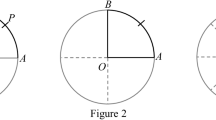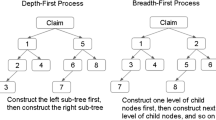Abstract
Students in secondary science education seem to have difficulties with understanding diagrams. The present study focused on explanatory factors that predict students’ difficulties with process diagrams, i.e., diagrams that describe a process consisting of components that are related by arrows. From 18 compulsory national Biology exams of secondary school pre-university students, all process diagram tasks (n = 64) were included in corpus. Features of the task, student, and diagram were related to the difficulty of that particular task, indicated by the cohort mean exam score. A hierarchical regression analysis showed main effects for (1) the cognitive task demand, (2) the familiarity of the components, and (3) the number of components in a diagram. All these main effects were in the expected direction. We also observed interactions. Within the category of tasks with a high cognitive demand, tasks about a diagram of which students have low prior content knowledge were more difficult than tasks about a diagram of which students have high prior content knowledge. Tasks with a high cognitive demand about a diagram with familiar arrows were, surprisingly, more difficult than tasks with a high cognitive demand about a diagram with unfamiliar arrows. This latter finding might be attributed to compensation for task difficulty by the large number of components in the diagrams involved. The final model explained 46 % of the variance in exam scores. These results suggest that students have difficulties (1) with tasks that require a deeper understanding when the content is new, (2) with diagrams that use unfamiliar component conventions, and (3) with diagrams that have a small number of components and are therefore probably more abstract.


Similar content being viewed by others
References
Aiken, L. S., & West, S. G. (1991). Multiple regression: testing and interpreting interactions. Newbury Park: Sage.
Ainsworth, S. (2006). DeFT: a conceptual framework for considering learning with multiple representations. Learning and Instruction, 16, 183–198.
Ainsworth, S., & Loizou, A. T. (2003). The effects of self-explaining when learning with text or diagrams. Cognitive Science, 27(4), 669–681.
Bezemer, J., & Kress, G. (2008). Writing in multimodal texts: a social semiotic account of designs for learning. Writing Communications, 25(2), 166–195.
Bielaczyc, K., Pirolli, P., & Brown, A. (1995). Training in self-explanation and self-regulation strategies—investigating the effects of knowledge acquisition activities on problem-solving. Cognition and Instruction, 13, 221–252.
Bloom, B. S., Krathwohl, D. R., & Masia, B. B. (1956). Taxonomy of educational objectives: the classification of educational goals. New York: McKay.
Bowen, G. M., & Roth, W. (2002). Why students may not learn to interpret scientific inscriptions. Research in Science Education, 32, 303–327.
Butcher, K. R. (2006). Learning from text with diagrams: Promoting mental model development and inference generation. Journal of Educational Psychology, 98(1), 182–197.
Campbell, N. A., & Reece, J. B. (2002). Biology (6th ed.). San Francisco: Pearson Education.
Canham, M., & Hegarty, M. (2010). Effects of knowledge and display design on comprehension of complex graphics. Learning and Instruction, 20, 155–166.
Carlson, R., Chandler, P., & Sweller, J. (2003). Learning and understanding science instructional material. Journal of Educational Psychology, 95(3), 629–640.
Chittleborough, G., & Treagust, D. (2008). Correct interpretation of chemical diagram requires transforming from one level of representation to another. Research in Science Education, 38, 463–482.
Cook, M., Wiebe, E. N., & Carter, G. (2008). The influence of prior knowledge on viewing and interpreting graphics with macroscopic and molecular representations. Science Education, 92, 848–867.
Cromley, J. G., Snyder-Hogan, L. E., & Luciw-Dubas, U. A. (2009). Cognitive activities in complex science text and diagrams. Contemporary Educational Psychology, 35, 59–74.
Crowe, A., Dirks, C., & Wenderoth, M. P. (2008). Biology in bloom: implementing Bloom’s Taxonomy to enhance student learning in biology. Life Sciences Education, 7, 368–381.
Frazier, P., Tix, A., & Barron, K. (2004). Testing moderator and mediator effects in counseling psychology research. Journal of Counseling Psychology, 51, 115–134.
Gilbert, J. K. (2005). Visualization: a metacognitive skill in science education. In J. K. Gilbert (Ed.), Visualization in science education (pp. 9–27). Dordrecht: Springer.
Guthrie, J. T., Shelley, W., & Kimmerly, N. (1993). Searching documents: cognitive processes and deficits in understanding graphs, tables, and illustrations. Contemporary Educational Psychology, 18, 186–221.
Hardy, M. A. (1993). Regression with dummy variables. Newbury Park: Sage.
Hegarty, M., & Just, M. A. (1989). Understanding machines form text and diagrams. In H. Mandl & J. Levin (Eds.), Knowledge acquisition from text and pictures (pp. 171–194). Amsterdam: North Holland.
Heiser, J., & Tversky, B. (2006). Arrows in comprehending and producing mechanical diagram. Cognitive Science, 30, 581–592.
Holliday, W. G., Brunner, L. L., & Donais, E. L. (1977). Differential cognitive and affective responses to flow diagrams in science. Journal of Research in Science Teaching, 14, 129–138.
Hoyle, R. H., Harris, M. J., & Judd, C. M. (2002). Research methods in social relations. USA: Wadsworth.
Kindfield, A. C. H. (1993). Biology diagrams: tools to think with. The Journal of the Learning Sciences, 3(1), 1–36.
Krathwohl, D. R. (2002). A revision of Bloom’s Taxonomy: an overview. Theory into Practice, 41(4), 212–218.
Larkin, J., & Simon, H. (1987). Why a diagram is (sometimes) worth ten thousand words. Cognitive Science, 11, 65–99.
Lowe, R. K. (1996). Background knowledge and the construction of a situational representation from a diagram. European Journal of Psychology of Education, 11(4), 377–397.
Mathai, S., & Ramadas, J. (2009). Visuals and visualisation of human body systems. International Journal of Science Education, 31(3), 439–458.
Mayer, R. E., & Gallini, J. K. (1990). When is an illustration worth ten thousand words? Journal of Educational Psychology, 82, 715–726.
Mayer, R. E., & Moreno, R. (1998). A split-attention effect in multimedia learning: evidence for dual processing systems in working memory. Journal of Educational Psychology, 90(2), 312–320.
Paivio, A. (1990). Mental representations. A dual coding approach. New York: Oxford University Press.
Raedts, M., Rijlaarsdam, G., Van Waes, L., & Daems, F. (2007). Observational learning through video-based models: impact on student’s writing accuracy of self-efficacy beliefs, task knowledge and writing performances. In P. Boscolo & S. Hidi (Eds.), Studies in writing, 20. Writing and motivation (pp. 219–238). Oxford: Elsevier.
Schönborn, K. J., Anderson, T. R., & Grayson, D. J. (2002). Student difficulties with the interpretation of a textbook diagram of immunoglobulin G (IgG). Biochemistry and Molecular Biology Education, 30(2), 93–97.
Sweller, J. (1994). Cognitive load theory, learning difficulty, and instructional design. Learning and Instruction, 4, 295–312.
Winn, W. D. (1982). The role of diagrammatic representation in learning sequences, identification, and classification as a function of verbal and spatial ability. Journal of Research in Science Teaching, 19, 79–89.
Winn, W. D. (1988). Recall of the pattern, sequence, and names of concepts presented in instructional diagrams. Journal of Research in Science Teaching, 25(5), 375–386.
Winn, W. D. (1991). Learning from maps and diagrams. Educational Psychology Review, 3(3), 211–247.
Winn, W. D. (1993). An account of how readers search for information in diagram. Contemporary Educational Psychology, 18, 162–185.
Winn, W. D., & Sutherland, S. W. (1989). Factors influencing the recall of elements in maps and diagrams and the strategies used to encode them. Journal of Educational Psychology, 81, 33–39.
Winn, W. D., Li, T.-Z., & Schill, D. E. (1991). Diagram as aids to problem solving: their role in facilitating search and computation. Educational Technology Research and Development, 39, 17–29.
Author information
Authors and Affiliations
Corresponding author
Rights and permissions
About this article
Cite this article
Kragten, M., Admiraal, W. & Rijlaarsdam, G. Diagrammatic Literacy in Secondary Science Education. Res Sci Educ 43, 1785–1800 (2013). https://doi.org/10.1007/s11165-012-9331-0
Published:
Issue Date:
DOI: https://doi.org/10.1007/s11165-012-9331-0




